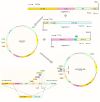Two Foreign Antimicrobial Peptides Expressed in the Chloroplast of Porphyridium purpureum Possessed Antibacterial Properties
- PMID: 36005487
- PMCID: PMC9409725
- DOI: 10.3390/md20080484
Two Foreign Antimicrobial Peptides Expressed in the Chloroplast of Porphyridium purpureum Possessed Antibacterial Properties
Abstract
To solve the problem of antibiotic abuse in aquaculture and to utilize the application potential of antimicrobial peptides (AMPs), a chloroplast transformation system of Porphyridium purpureum was successfully constructed for effectively expressing two exogenous AMPs. The endogenous fragments of 16S rDNA/trnA-23S rDNA were used as flanking fragments for the homologous recombination in the chloroplast genome. Two AMPs encoded by the transformation vector were controlled by the native promoter psbB in a polycistron. The plasmids were transferred into P. purpureum via particle bombardment and the transformation vectors were screened using phosphinothricin (bar), a dominant selection marker under the control of the psbA promoter. Subsequently, in the positive transformed colonies, the exogenous fragments were found to be inserted in the flanking fragments directionally as expected and two foreign AMPs were successfully obtained. Finally, two exogenous peptides with antibacterial properties were obtained from the transformed strain. The two AMPs expressed by the transformed strain were shown to have similar inhibitory effects to antibiotics by inhibition tests. This suggested that AMPs can be introduced into aquaculture using baited microalgae, providing new ideas and ways to solve a series of aquaculture diseases caused by bacteria.
Keywords: NZ2114; Piscidin-4; Porphyridium purpureum; antimicrobial peptides; chloroplast transformation system; inhibitory effect; microparticle bombardment.
Conflict of interest statement
The authors declare no conflict of interest.
Figures



Similar articles
-
Plastid Engineering of a Marine Alga, Nannochloropsis gaditana, for Co-Expression of Two Recombinant Peptides.J Phycol. 2021 Apr;57(2):569-576. doi: 10.1111/jpy.13099. Epub 2021 Feb 2. J Phycol. 2021. PMID: 33174215
-
Chloroplast Genetic Engineering of a Unicellular Green Alga Haematococcus pluvialis with Expression of an Antimicrobial Peptide.Mar Biotechnol (NY). 2020 Aug;22(4):572-580. doi: 10.1007/s10126-020-09978-z. Epub 2020 Jun 13. Mar Biotechnol (NY). 2020. PMID: 32535692
-
Stable nuclear transformation of rhodophyte species Porphyridium purpureum: advanced molecular tools and an optimized method.Photosynth Res. 2019 May;140(2):173-188. doi: 10.1007/s11120-018-0587-8. Epub 2018 Oct 1. Photosynth Res. 2019. PMID: 30276605
-
Antimicrobial peptides (AMPs) from microalgae as an alternative to conventional antibiotics in aquaculture.Prep Biochem Biotechnol. 2025 Jan;55(1):26-35. doi: 10.1080/10826068.2024.2365357. Epub 2024 Jul 6. Prep Biochem Biotechnol. 2025. PMID: 38970798 Review.
-
Tools and techniques for rational designing of antimicrobial peptides for aquaculture.Fish Shellfish Immunol. 2022 Aug;127:1033-1050. doi: 10.1016/j.fsi.2022.07.055. Epub 2022 Jul 22. Fish Shellfish Immunol. 2022. PMID: 35872334 Review.
Cited by
-
Heterologous Production of Antimicrobial Peptides: Notes to Consider.Protein J. 2024 Apr;43(2):129-158. doi: 10.1007/s10930-023-10174-w. Epub 2024 Jan 5. Protein J. 2024. PMID: 38180586
-
Study of the Antimicrobial Potential of the Arthrospira platensis, Planktothrix agardhii, Leptolyngbya cf. ectocarpi, Roholtiella mixta nov., Tetraselmis viridis, and Nanofrustulum shiloi against Gram-Positive, Gram-Negative Bacteria, and Mycobacteria.Mar Drugs. 2023 Sep 14;21(9):492. doi: 10.3390/md21090492. Mar Drugs. 2023. PMID: 37755105 Free PMC article.
-
Designing a Potent, Low-Toxicity Antimicrobial Peptide Inspired by Scorpion Peptides: Optimizing Expression and Activity.Probiotics Antimicrob Proteins. 2025 Jul 2. doi: 10.1007/s12602-025-10637-9. Online ahead of print. Probiotics Antimicrob Proteins. 2025. PMID: 40593394
-
Evaluation of the activity of antimicrobial peptides against bacterial vaginosis.Open Life Sci. 2024 Jul 30;19(1):20220927. doi: 10.1515/biol-2022-0927. eCollection 2024. Open Life Sci. 2024. PMID: 39091626 Free PMC article.
References
-
- Dadar M., Dhama K., Vakharia V.N., Hoseinifar S.H., Karthik K., Tiwari R., Khandia R., Munjal A., Salgado-Miranda C., Joshi S.K. Advances in Aquaculture Vaccines Against Fish Pathogens: Global Status and Current Trends. Rev. Fish. Sci. Aquac. 2016;25:184–217. doi: 10.1080/23308249.2016.1261277. - DOI
-
- Nayak A., Karunasagar I., Chakraborty A., Maiti B. Potential application of bacteriocins for sustainable aquaculture. Rev. Aquac. 2021;14:1234–1248. doi: 10.1111/raq.12647. - DOI
MeSH terms
Substances
Grants and funding
LinkOut - more resources
Full Text Sources

